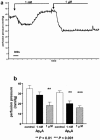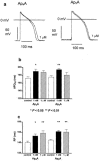Changes in extracellular pH and myocardial ischaemia alter the cardiac effects of diadenosine tetraphosphate and pentaphosphate
- PMID: 11588119
- PMCID: PMC1572982
- DOI: 10.1038/sj.bjp.0704288
Changes in extracellular pH and myocardial ischaemia alter the cardiac effects of diadenosine tetraphosphate and pentaphosphate
Abstract
1. The structural conformation of diadenosine tetraphosphate (Ap(4)A) and pentaphosphate (Ap(5)A) has been reported to alter as pH is reduced. As such, it is possible that the cardiac effects of Ap(4)A and Ap(5)A vary during acidosis and myocardial ischaemia due to changes in ligand structure, receptor proteins or intracellular signalling. 2. We investigated whether the cardiac electrophysiological and coronary vasomotor effects of Ap(4)A and Ap(5)A are preserved under conditions of extracellular acidosis (pH 6.5) and alkalosis (pH 8.5) and whether Ap(4)A has any electrophysiological or antiarrhythmic effects during ischaemia. 3. Transmembrane right ventricular action potentials, refractory periods and coronary perfusion pressure were recorded from isolated, Langendorff-perfused guinea-pig hearts under constant flow conditions. The effects of 1 nM and 1 microM Ap(4)A and Ap(5)A were studied at pH 7.4, 6.5 and 8.5. The effects of 1 microM Ap(4)A were studied during global low-flow ischaemia and reperfusion. 4. At pH 7.4, Ap(4)A and Ap(5)A increased action potential duration (APD(95)) and refractory period (RP) and reduced coronary perfusion pressure. The electrophysiological effects were absent at pH 6.5 while the reductions in perfusion pressure were attenuated. At pH 8.5, Ap(4)A increased RP but the effects of Ap(4)A and Ap(5)A on perfusion pressure were attenuated. During ischaemia, Ap(4)A had no antiarrhythmic or electrophysiological effects. 5. These data demonstrate the importance of extracellular pH in influencing the effects of Ap(4)A and Ap(5)A on the heart and indicate that any potentially cardioprotective effects of these compounds during normal perfusion at physiological pH are absent during ischaemia.
Figures





Similar articles
-
Contribution of nitric oxide and prostanoids to the cardiac electrophysiological and coronary vasomotor effects of diadenosine polyphosphates.J Pharmacol Exp Ther. 2001 Aug;298(2):531-8. J Pharmacol Exp Ther. 2001. PMID: 11454914
-
Nitric oxide and prostacyclin modulate the alterations in cardiac action potential duration mediated by platelets during ischaemia.Cardiovasc Res. 1995 Nov;30(5):788-98. Cardiovasc Res. 1995. PMID: 8595628
-
Coronary vasomotor and cardiac electrophysiologic effects of diadenosine polyphosphates and nonhydrolyzable analogs in the guinea pig.J Cardiovasc Pharmacol. 2001 May;37(5):571-84. doi: 10.1097/00005344-200105000-00009. J Cardiovasc Pharmacol. 2001. PMID: 11336108
-
Diadenosine polyphosphates: postulated mechanisms mediating the cardiac effects.Curr Med Chem Cardiovasc Hematol Agents. 2003 Jun;1(2):151-69. doi: 10.2174/1568016033477513. Curr Med Chem Cardiovasc Hematol Agents. 2003. PMID: 15320695 Review.
-
The effects of diadenosine polyphosphates on the cardiovascular system.Cardiovasc Res. 1999 Apr;42(1):15-26. doi: 10.1016/s0008-6363(99)00004-8. Cardiovasc Res. 1999. PMID: 10434992 Review.
Cited by
-
Fabrication and Characterization of Drug-Loaded Conductive Poly(glycerol sebacate)/Nanoparticle-Based Composite Patch for Myocardial Infarction Applications.ACS Appl Mater Interfaces. 2020 Feb 12;12(6):6899-6909. doi: 10.1021/acsami.9b21066. Epub 2020 Feb 3. ACS Appl Mater Interfaces. 2020. PMID: 31967771 Free PMC article.
-
Diadenosine-5-phosphate exerts A1-receptor-mediated proarrhythmic effects in rabbit atrial myocardium.Br J Pharmacol. 2003 Aug;139(7):1265-72. doi: 10.1038/sj.bjp.0705361. Br J Pharmacol. 2003. PMID: 12890705 Free PMC article.
References
-
- AHMET I., SAWA Y., NISHIMURA M., ICHIKAWA H., MATSUDA H. Diadenosine tetraphosphate (AP4A) mimics cardioprotective effect of ischemic preconditioning in the rat heart: contribution of KATP channel and PKC. Basic Res. Cardiol. 2000a;95:235–242. - PubMed
-
- AHMET I., SAWA Y., NISHIMURA M., KITAKAZE M., MATSUDA H. Cardioprotective effect of diadenosine tetraphosphate (AP4A) preservation in hypothermic storage and its relation with mitochondrial ATP-sensitive potassium channels. Transplantation. 2000b;69:16–20. - PubMed
-
- AHMET I., SAWA Y., NISHIMURA M., MATSUDA H. Cardioprotective effect of diadenosine tetraphosphate (AP4A) cardioplegia in isolated rat hearts. Heart Vessels. 2000c;15:30–34. - PubMed
-
- AHMET I., SAWA Y., NISHIMURA M., YAMAGUCHI T., KITAKAZE M., MATSUDA H. Myocardial protection using diadenosine tetraphosphate with pharmacological preconditioning. Ann. Thorac. Surg. 2000d;70:901–905. - PubMed
-
- BEAULOYE C., BERTRAND L., KRAUSE U., MARSIN A.-S., DRESSELAERS T., VANSTAPEL F., VANOVERSCHELDE J.-L., HUE L. No-flow ischemia inhibits insulin signaling in heart by decreasing intracellular pH. Circ. Res. 2001;88:513–519. - PubMed
Publication types
MeSH terms
Substances
LinkOut - more resources
Full Text Sources
Medical
Research Materials

